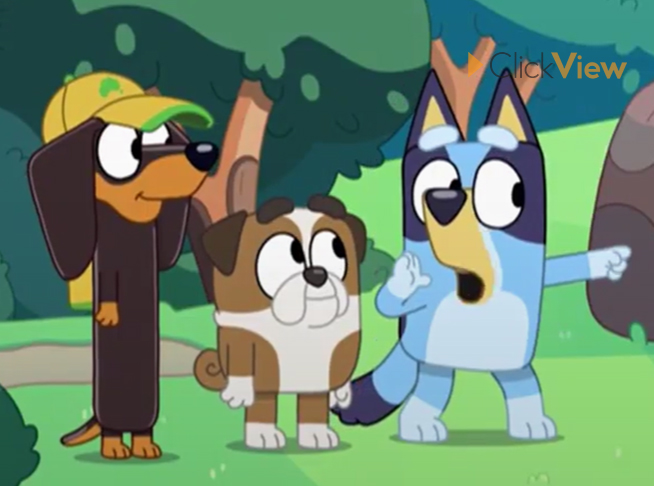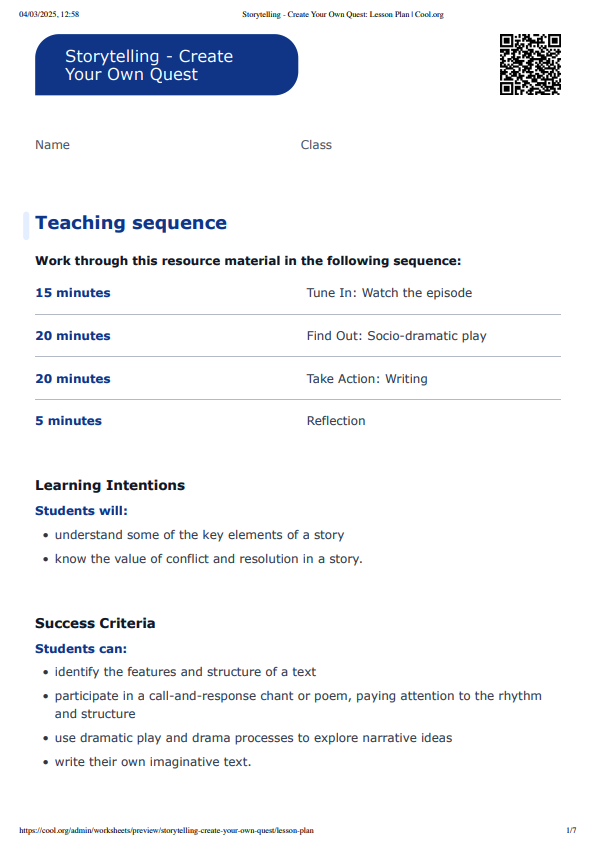Lesson summary
The animated series Bluey serves as a valuable tool in fostering children's development of imagination, curiosity, and social and emotional learning.
This lesson focuses on the capability of 'storytelling'. Students will begin by acting out a quest-style story, posing obstacles and overcoming them using critical and creative reasoning. They will then create their own imaginative quest-style stories.
This suite of resources supports emotional and social learning and oral language development through a values framework. Each lesson uses intentional teaching strategies to develop a specific value. This lesson focuses on

Click here for a full list of the values that underpin these activities.
This lesson showcases a Bluey episode, which can be viewed on ClickView. Don't have a ClickView subscription? Bluey is also available on ABC iView. For real life!
Learning intentions
Students will:
- understand some of the key elements of a story
- know the value of conflict and resolution in a story.
Success criteria
Students can:
- identify the features and structure of a text
- participate in a call-and-response chant or poem, paying attention to the rhythm and structure
- use dramatic play and drama processes to explore narrative ideas
- write their own imaginative text.
Lesson guides and printables
Curriculum links
Select your curriculum from the options below.
Lesson details
Curriculum Mapping
Australian Curriculum (v9.0) content description:
Foundation Year English
- Recognise different types of literary texts and identify features including events, characters, and beginnings and endings (AC9EFLE03)
- Retell and adapt familiar literary texts through play, performance, images or writing (AC9EFLE05)
Year 1 English
- Discuss plot, character and setting, which are features of stories (AC9E1LE03)
- Create and re-read to edit short written and/or multimodal texts to report on a topic, express an opinion or recount a real or imagined event, using grammatically correct simple sentences, some topic-specific vocabulary, sentence boundary punctuation and correct spelling of some one- and two-syllable words (AC9E1LY06)
Year 2 English
- Discuss the characters and settings of a range of texts and identify how language is used to present these features in different ways (AC9E2LE03)
- Create and edit short imaginative, informative and persuasive written and/or multimodal texts for familiar audiences, using text structure appropriate to purpose, simple and compound sentences, noun groups and verb groups, topic-specific vocabulary, simple punctuation and common 2-syllable words (AC9E2LY06)
Syllabus outcomes:
General capabilities: Literacy
Relevant parts of Foundation Year English achievement standards: Students listen to texts, interact with others and create short spoken texts, including retelling stories. They read, view and comprehend texts, making connections between characters, settings and events, and to personal experiences.
Relevant parts of Year 1 English achievement standards: Students read, view and comprehend texts, monitoring meaning and making connections between the depiction of characters, settings and events, and to personal experiences. They create short written and/or multimodal texts including recounts of stories with events and characters.
Relevant parts of Year 2 English achievement standards: Students read, view and comprehend texts, identifying literal and inferred meaning, and how ideas are presented through characters and events. They create written and/or multimodal texts including stories to inform, express an opinion, adapt an idea or narrate for audiences.
Level of teacher scaffolding: High - Facilitate discussion, lead students in socio-dramatic play and support students in creating their own texts.
Resources Required
- device capable of presenting a video to students
- whiteboard
- writing materials.
Additional Info
This is not an official Bluey lesson. Cool.org does not have an official partnership with Bluey.


Welcome back!
Don't have an account yet?
Log in with:
Create your free Cool.org account.
Many of our resources are free, with an option to upgrade to Cool+ for premium content.
Already have an account?
Sign up with:
By signing up you accept Cool.org's Terms and Conditions(Opens in new tab) and Privacy Policy(Opens in new tab).